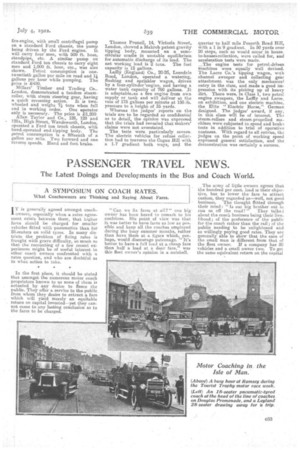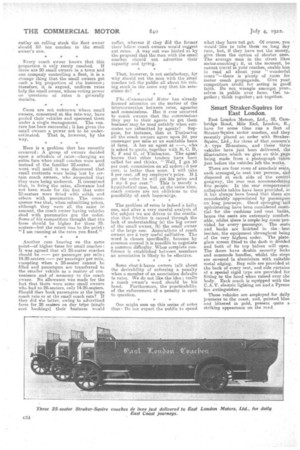PASSENGER TRAVEL NEWS.
Page 29

Page 30

If you've noticed an error in this article please click here to report it so we can fix it.
The Latest Doings and Developments in the Bus and Coach World.
IT is generally agreed amongst coachowners, especially when a rates agreement exists between them, that higher fares should be charged for smaller vehicles fitted with pneumatics than for 28-seaters on solid tyres. In many districts the problem of fixing rates is fraught with grave difficulty, so much so that the recounting of a few recent experiences might, be of useful interest to other coach owners confronted with a rates question, and who are doubtful as to what, action to take.
Inthe first place, it should he stated that amongst the numerous motor coach
proprietors no
known to us none of them is actuated by any desire to fleece the public. They offer a service to the public. from whom they desire to extract a fare which will yield merely an equitable
nv nv
return on capital invested—yet they can, not come to any lasting conclusion as to the fares to be charged. "Can we fix fares at all?" one big owner has been heard to remark to his confreres. His point of view was that it, was better to have fares as low as posa sible and keep all the coaches employed during the busy summer months, rather than have them at a figure which, perhaps, would discourage patronage. "It's better to have a fell load at a cheap fare than half a load at a dear fare," was this fleet owner's opinion in a nutshell. The army of little owners agrees that the hundred per cent, load is theirobjective, but to lower the fare to attract custom, they regarded as—well, not good business. The thought flitted through their mind "Is Is our big brother out to run us off the road? " They talke,i about the coacla business being thcin livelihood; of the preference of the public for the coach rather than the rail ; of the public needing to be enlightened and so willingly paying good rates. They are generally able to show that the case of the small man is different from that of the fleet. owner. If a company has 20 vehicles and a small owner two. To get the same equivalent return on the capital
outlay on rolling stock the fleetowner should fill ten coaches to the small owner's one.
Every coach owner knows that this proportion is only rarely reached. E there are 20 small owners in a town and one companY controlling a fleet, it is a strange thing that the small owners get such a big. proportion of the business; therefore, it is argued, uniform rates help the small owner, whose voting power on questions of rates is generally decisive.
Cases are not, unknown: where small owners, concerned at the rate-war, have pooled their vehicles and operated them under a single management. The yen-. tare has been successful; it has given the small owners a power not to be under estimated. That is, however, by the way.
Here is a problem that has recently occurred: A group of owners decided upon a schedule of rates—charging an extra fare when small coaches were used
instead of the familiar 28-seater. All went well until it was discovered that small contracts were being lost by certain coach owners, who suspected thatthey were being undercut. It transpired that, iii fixing the rates, allowance had not been made for the fact that some 23-seaters were fitted with solids and others with pneumatics. The
Consequence was that, when submitting prices, although they were all the same in amount, the coach owner having vehicles shod with pneumatics got the order. Some of his competitors thought that the fares should be higher for these 28. seaters—bat the retort was to the point: "I am running at the rates you fixed."
Another case bearing on the same point—of higher fares for small coaches : It was agreed that all 28-seater coaches should be — per passenger per mile; 14-20-seaters — per passenger per mile, excepting when a 28-seater cannot be filled and passengers are transferred to the smaller vehicle as a matter of convenience and of economy to the coach owner. No allowance was made for the fact that there were some small owners who had no 28-seaters, only 14-20-seaters. Should they hook passengers at the large coach rate or at the small coach rate? If they did aZie latter, owing to advertised fares for 28 seatars on day trips (single eeat bookings) their business would suffer, whereas if they did the former their fellow coach owners would suggest cut rates. A way out was hinted at by the proposal that the man with the smail coaches -should not advertise their capacity aud tyring.
That, however, is not satisfactory, for why should not the man with the small coaches tell the public all about his rolling stock in the same way that his associates do?
The ..Commocial .2110 for has already focused attention on the matter of the interconnection between rates, agencies and commissions. Has it ever occurred to coach owners that the commissions they pay to their agents to get them business may he used unfairly when estimates are submitted by agents? Suppose, for instance, that at Timbuctoo all the coach owners agree upon 2d. per passenger per mile as an equitable basis of fares. A has an agent at a--=, .who is asked to quote, together With B, C, Di• E, F and G, of Timbuctoo. The-agent knows that other tenders have been called for and thinks," Well, I get .10 per cent, commission on all orders ;s5 per cent. is better than none. I will take 5 per cent. off my employer's price. If Iget the order he will get his price and I my. 5 per cent."This is .merely a hypothetical ease, but, at the same tiine,. coach owners are not .oblivious to the possibility of such happenings.
The problem of rates is indeed -a betty one, and after a very careful analysis of the subject we are driven td the &meinsion that friction. i5 caused through the lack of understanding (a) the big owner of the small owner, (b) the small owner of the large one. Associationa of coach owners are a very useful palliative: The word is chosen specifically, because by common counsel it is possible to negotiate a common difficulty. When complete confidence is established between members an association is likely to be effective.
Some char4-bancs owners talk about the desirability of enforcing a penalty when a member of an association defaults in rates. We do not like the idea ; really a coach owner's word should be his bond. Furthermore, the practicability of the enforcement of a penalty is open to question.
One might sum up this series of notes thus : Do not. (aspect the public to spend
what they have not got. Of course, you would -like to take them r' on long day runs, but, if they have not the money, give them the option of shorter ones. The average man in the street likes motarscoaching; if, at the moments he cannot travel in your coaches, enable hint to read all about your "wonderful tours "—there is plenty of room for motor coach propagahda. Give your, competitors credit for acting in goo& faith. Do not wrangle amongst your-, selves in public over fares. Gettogather; think together; act together.
Smart Straker-Squires for East London..
East London Motors, Ltd. 52, Cam-. bridge Road, Mile End, London, have for some tune run a fleet of Straker-Squire motor coaches and they, recently placed an order with StrakerSquire, Ltd., for three of that asoncern's Atype 25-seakera, and these three velliciles have just been delivered, the illustration which we give on this page being made from a photograph taken just before the vehicles left the works.
There ate four rows of armohair seats, ca-oh arranged, to -seat twci persons, dispoaed at each side of the central gangway, the rear seat accommodating
fisia people. the rear compeatment collapsable tables have been provided, as it has always been found that these are considerably 'appreciated by pasSerigers -on long journeys. Good springing,--and upholstering have been considered easentia:r for the cushions and -seat backs, hence the seats are extremely .Condortable, Whilot there is ample-leg room 'proyided for every passenger.. The seats and backs are finished in the ,:best feather, the equipment throughout being of the very highest order. The plateglass screen fitted to the dash is divided and both of its top halves will open. The doors have double security locks and commode handles, whilst the steps are covered in aluminium with suitable metal edging. Rug rails are provided at the back of every seat, and side curtains of a special rigid type are provided for fitting to the hood WECti raised over the body. Each coach is equipped with the C.A.V. electric lighting set coda Pyrene fire extinguisher.
These .vehiodes arc employed for daily journeys to the coast, and, paint-ed blue and lettered in gold, present quite a striking appearance on the road.








































